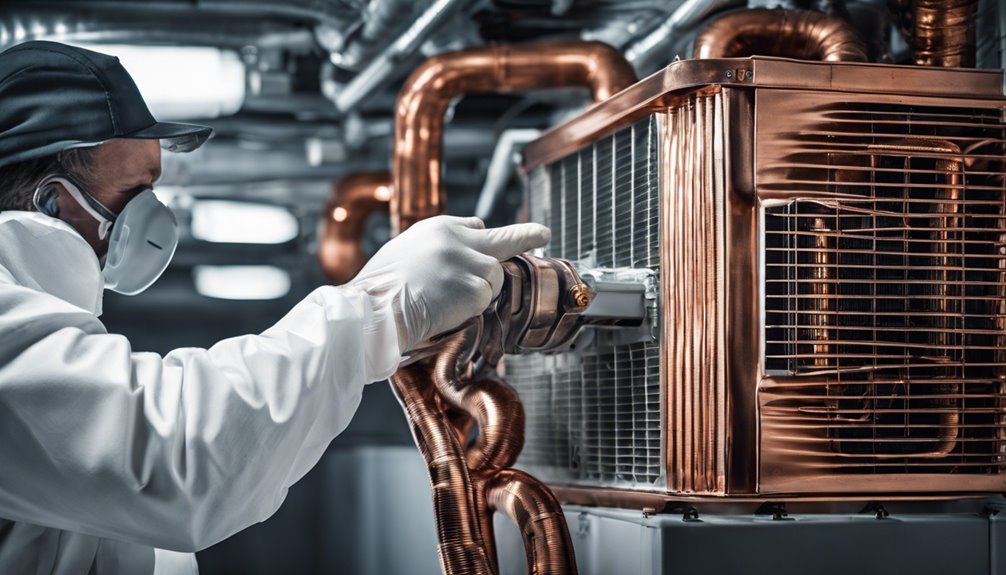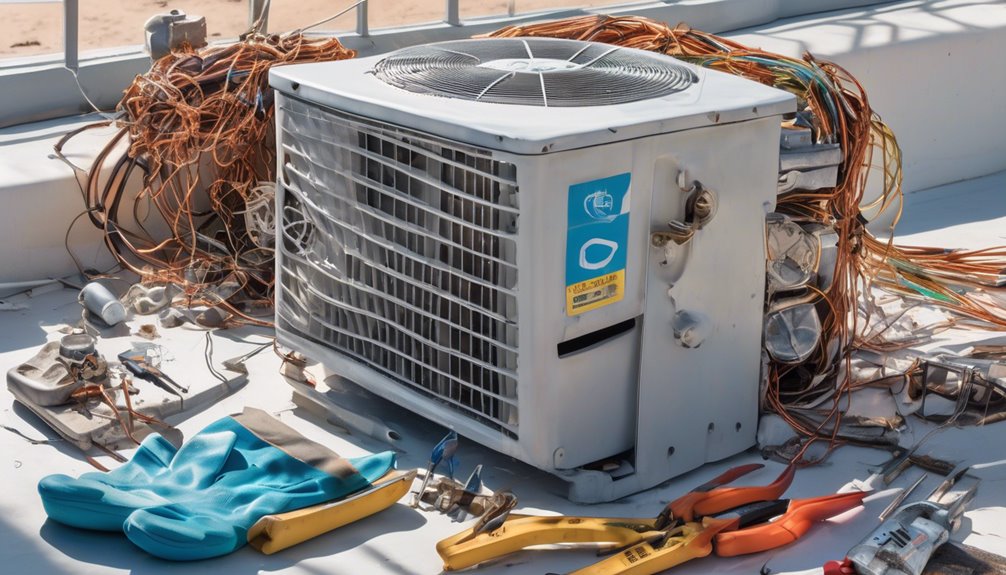To keep your AC system running smoothly, you'll want to check a few key components regularly. Start by inspecting and replacing air filters, verifying thermostat settings, and detecting refrigerant leaks. Don't forget to clean condenser coils, ensure the drainage system is clog-free, and maintain the blower motor. Finally, inspect electrical connections for worn insulation and loose bolts. By checking these areas, you'll be able to identify potential issues before they become major problems, and you'll be well on your way to optimal AC performance.
Key Takeaways
- Inspect and replace air filters regularly to prevent dust accumulation and decrease airflow.
- Check thermostat settings to ensure correct temperature readings and mode settings, and verify sensor calibration.
- Regularly inspect condenser coils for dirt, dust, and damage, and clean them every 1-2 months or as needed.
- Check for refrigerant leaks using effective detection methods and inspect for signs of oil or refrigerant around connections.
- Verify drainage tubes are clog-free and securely connected, and inspect the blower motor for dust and debris accumulation.
Air Filters
Air filters are a crucial component of your AC system, responsible for capturing dust, dirt, and other airborne particles that can compromise indoor air quality and system performance.
You need to inspect and replace them regularly to prevent dust accumulation, which can decrease airflow and increase energy consumption. Make sure to choose high-quality filters that can capture even the smallest particles.
A good filter can significantly improve your indoor air quality and reduce the risk of respiratory problems. Don't compromise on filter quality, as it can affect the overall performance of your AC system.
Thermostat Settings
You adjust your thermostat daily, but have you checked if it's providing correct temperature readings?
It's also essential to verify the mode settings, ensuring you're not wasting energy on unnecessary heating or cooling.
Additionally, don't forget to check the battery health to prevent sudden thermostat failures.
Correct Temperature Readings
Setting your thermostat to the correct temperature is crucial for optimal AC system performance.
You'll want to ensure the temperature reading on your thermostat is accurate to avoid temperature fluctuation, which can lead to inefficient cooling and increased energy bills.
To achieve this, check your thermostat's sensor calibration to ensure it's providing accurate readings. You can do this by comparing the thermostat's reading with a separate thermometer.
If the readings don't match, you may need to adjust or replace the sensor.
Battery Health Check
As your thermostat relies on its battery to function properly, it's vital to check its health regularly to prevent any disruptions to your AC system's performance.
You should inspect the battery for signs of corrosion, which can cause it to drain quickly. Clean the terminals and remove any corrosion you find. Regular battery maintenance is crucial to extend its lifespan.
If your thermostat has a low-battery indicator, make sure to check it frequently. Replace the battery as recommended by the manufacturer to ensure your thermostat continues to function correctly.
Mode Settings Verification
The thermostat's mode settings play a crucial role in regulating your AC system's performance, and verifying these settings is essential to ensure your desired indoor climate.
You should check your thermostat's mode settings regularly to ensure they're set correctly. This is especially important during summer mode when you want to maximize energy efficiency.
Here's what you should verify:
- That your thermostat is set to "cool" mode during summer and "heat" mode during winter
- The temperature settings are at a comfortable level for you
- The fan mode is set to "auto" to ensure efficient airflow
- The system is set to "energy-saving" mode when you're not home or sleeping
- The schedule is set correctly to reflect your daily routine
Refrigerant Leaks
You're likely to encounter refrigerant leaks in your AC system, especially if it's been in use for a while.
Refrigerant leaks can be particularly problematic due to the unique characteristics of refrigerants, which can escape through even the tiniest openings.
To detect leaks, you'll need to employ effective leak detection methods. One common method is to use a refrigerant leak detector, which can sense the presence of refrigerant in the air.
You can also perform a visual inspection, looking for signs of oil or refrigerant around connections, valves, and other components.
Additionally, you can check the system's pressure gauge to identify any unusual drops in pressure, which can indicate a leak.
Condenser Coils
Dirty condenser coils can silently sabotage your AC system's performance, causing it to work harder and consume more energy.
As you inspect your condenser coils, look for signs of dirt and dust accumulation.
Dusty surfaces can reduce airflow and insulation, making your AC work harder to cool your space.
- Check for leaves, twigs, and other debris stuck to the coils
- Inspect the coils for bent or damaged fins
- Look for signs of rust or corrosion
- Check if the coil cleaning brush is clogged with dirt and debris
- Consider cleaning the coils every 1-2 months, or as needed
Drainage System
You'll want to ensure your AC's drainage system is functioning properly to prevent water damage and mold growth.
Start by checking that your drainage tubes are clog-free, as blockages can cause water to back up and leak into your system. Additionally, consider investing in a water leak detection system to catch any potential issues before they become major problems.
Clog-Free Drainage Tubes
A crucial aspect of AC system maintenance is ensuring clog-free drainage tubes, a vital component of the drainage system.
You need to check these tubes regularly to prevent debris accumulation, which can lead to tube blockage and AC system failure.
- Check the drainage tubes for kinks or bends that can restrict water flow
- Look for signs of mold or mildew growth, indicating water buildup
- Verify that the tubes are securely connected to the AC unit
- Inspect the tubes for any cracks or damage that can cause leaks
- Clean the tubes with a soft brush or cloth to remove any dirt or debris
Water Leak Detection
As you've ensured the drainage tubes are clear and functioning properly, it's now important to monitor the entire drainage system for any signs of water leaks.
You can do this by installing moisture sensors in areas prone to water damage, such as near the condenser coil or around the air handler unit. These sensors will detect even the slightest moisture levels, alerting you to potential leaks before they cause significant damage.
Keep an eye out for water damage signs like water spots, warping, or discoloration on walls, ceilings, or floors.
Regularly inspect the drainage system's connections, fittings, and pans for signs of rust, corrosion, or mineral buildup, which can indicate a leak.
Blower Motor
The blower motor, a crucial component of your AC system, plays a vital role in circulating cooled air throughout your home.
As you inspect your AC system, don't overlook the blower motor's importance in maintaining a comfortable indoor climate. Regular motor maintenance is essential to ensure blower efficiency and prevent breakdowns.
To keep your blower motor running smoothly:
- Check for dust and debris accumulation on the motor housing and fan blades
- Verify that the motor is properly lubricated
- Inspect the blower motor's electrical components for signs of wear or damage
- Ensure the motor is securely fastened to the AC unit
- Look for unusual noises or vibrations during operation
Electrical Connections
Your AC system's electrical connections are just as important as the blower motor you've just inspected.
Make sure to check them regularly to avoid any potential issues. Look for worn insulation on wires, which can cause electrical shocks or even fires. If you notice any signs of wear, replace the wires immediately.
Also, check the connections themselves, tightening bolts and screws to ensure a secure fit. Loose connections can lead to electrical arcing, which can damage your AC system's components.
Frequently Asked Questions
How Often Should I Replace My AC System's Capacitors?
You should replace your AC system's capacitors every 5-7 years, but their lifespan can vary due to electrical surges, usage, and quality – keep an eye out for signs of wear, like bulging or rust, and consider replacing them sooner if you notice any issues.
What Causes My AC to Make Strange Noises at Night?
You're probably wondering why your AC is making strange noises at night – it's likely due to a nighttime hum from the compressor or a hissing air leak in the ductwork, which you should investigate to prevent further issues.
Can I Use a Dehumidifier With My AC System?
You can use a dehumidifier with your AC system, but adjust the dehumidifier settings according to your humidity levels. If it's extremely humid, you'll want to run the dehumidifier before turning on the AC to optimize performance and energy efficiency.
How Do I Know if My AC System Is Oversized?
You're wondering if your AC system is oversized? Check if it cools your space too quickly, as this can decrease system efficiency. If it does, it might be oversized, wasting energy and increasing cooling capacity unnecessarily.
Can I DIY AC Repairs or Should I Hire a Pro?
You're wondering if you can DIY AC repairs or hire a pro? Be honest, you're not a pro, so know your DIY limits to avoid further damage. If unsure, factor in Pro costs and consider hiring a licensed technician for complex issues.
Conclusion
You've made it to the end of the checklist! By regularly inspecting your air filters, thermostat settings, refrigerant leaks, condenser coils, drainage system, blower motor, and electrical connections, you'll ensure your AC system runs smoothly and efficiently. Catching small issues early on can save you from costly repairs and even prevent breakdowns during the hottest summer months. Stay on top of maintenance and enjoy a cool, comfortable home all season long!



